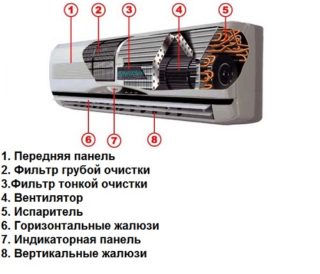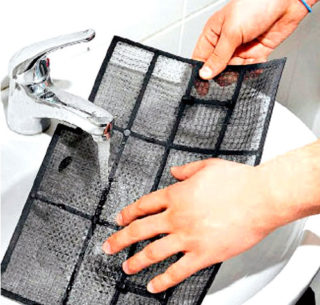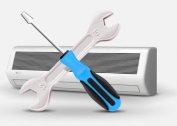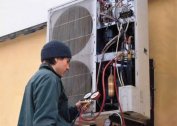Correct operation of HVAC equipment assumes that air in the system will circulate freely. If the passage of air masses is disrupted, and the air conditioner loses power, the fine filters are most likely clogged.
Air Filtration Types
In household air conditioners, there are two types of filters:
- Rough cleaning. Located right under the front panel. Material - plastic or metal. In cheap models, the mesh is flat. In expensive ones, it’s voluminous, which allows you to trap more debris and dust without passing them to thin filters. Air flows more freely through the volumetric grille, even when heavily soiled. The service life is unlimited, as the material is durable and is protected by the panel.
- Fine cleaning - bacterial, ultraviolet, electrostatic, adsorbing, plasma filters, photocatalytic.
By effectiveness, the cleaning elements are distributed as follows:
- Coarse cleaning - the main volume of dust settles on them.
- Electrostatic and plasma. Dust less than 2 microns is collected, transferring a negative charge to the particles. Service life is not limited.
- Other. Efficiency is doubtful, since most often manufacturers attribute to them a nonexistent impact in order to increase sales of budget models. An example is a filter with vitamin C. This vitamin is taken orally, but is not obtained from the air.
When choosing an air conditioner, you should look at its reliability, performance and noise characteristics. Mesh and fine filters should be regularly looked after, as well as the inside of the air conditioner.
Replacing the filter in the air conditioner will not help if the fan, heat exchanger and drainage system are left dirty.
Why clean the filters
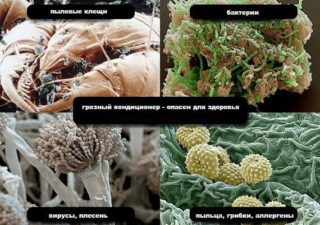 If there are animals at home or there is a lot of dust in the air, you need to clean the strainer about once every 3 weeks. Wool, accumulating on the grill, creates an obstacle to the flow of air. This reduces the efficiency of the split system and increases the load on the compressor, which overheats. Other parts also cannot work properly if clogged with dirt.
If there are animals at home or there is a lot of dust in the air, you need to clean the strainer about once every 3 weeks. Wool, accumulating on the grill, creates an obstacle to the flow of air. This reduces the efficiency of the split system and increases the load on the compressor, which overheats. Other parts also cannot work properly if clogged with dirt.
Air conditioners are a great place to propagate a huge number of harmful microorganisms. In the internal block dust, particles of epithelium, soot accumulate. With the flow of air, they spread around the room and cause various diseases - most often - the respiratory system. The most dangerous are legionella, which can cause pneumonia.
The most famous fatal case occurred in Philadelphia at a congress of war veterans. People lived in an air-conditioned hotel with bacteria in their ventilation fluid. 34 people died from pneumonia.
You should urgently consult a doctor if the disease started in the summer, and the person was in a room with a split system.
If the conditioner, which has not been cleaned for a long time, is disassembled, one can see dirt similar to moss on the impeller. An unpleasant smell comes from him and microbes and fungus actively multiply there.
The statistics are sad: a third of those with pneumonia do not survive. Particularly at risk are people with weak immunity, smokers.
- The air emitted by the indoor unit will no longer smell specific.
- Harmful microbes and allergens inside will be destroyed.
- The system will become quieter.
- Condensation will stop dripping inside the room.
How to clean the air conditioner
In summer, the procedure is performed once a month or more often.Cleaning the air conditioner filter takes no more than 10 minutes with a reverse installation. It is only necessary once to try to do it yourself and see the accumulation of dirt on the filter. Next, there will be a desire to care for the equipment in order to prevent pollution. Once a year, a general cleaning of the indoor and outdoor units is done. It is trusted by professional craftsmen from the service.
- Before cleaning your home air conditioner, clean the outdoor unit. Dust and cobwebs on the heat exchanger provide additional load on the device, causing overheating and burnout.
- Blow through the drain pipe. When it clogs, from the insidethe air conditioner starts to drip. In some designs, it is impossible to get to drainage without the help of a specialist.
- Open the top cover of the indoor unit of the air conditioner by gently pulling it forward and up.
- Remove the filter: grab the lower ends and lift them out of the grooves.
- Rinse the filter thoroughly and gently under running water at room temperature (hot can cause it to bend). Non-aggressive detergents can be used, as there may be particles of fat on the net.
- Inspect the inside of the air conditioner for dirt or dust. You can use household cleaning products for the kitchen to clean the fan drum with your own hands. After processing the surface, you need to leave it for ten minutes, after which using a match with a cotton to remove dirt between the blades. Use a room sprayer to thoroughly spray all surfaces, washing off the dirt. An oxygen bleach for laundry can be used to clean the heat exchanger in the indoor unit.
- Install the washed filter after it has completely dried. It captures particles harmful to the body and prevents them from getting into the internal parts of the air conditioner. The more dust settles on the heat exchanger, the lower the efficiency of the device.
- Treat the filter and the internal parts of the radiator with an antiseptic, and then set the air conditioner to cold air.
The service life of a thin filter is indicated in the instructions if it is supplied with the device as standard. If the filter runs out of time, it is replaced with a new one.
When to change the fine filter
Some filters do not need to be changed, only periodically cleaned. Their service life is equal to the life of the air conditioner.
For information:
- carbon filters change every 4 to 5 months;
- zeolite - 1 time in 5 years;
- Plasma have an unlimited life;
- electrostatic from paper - once every 4 months, from more resistant material they work unlimitedly;
- photocatalytic ones are limited by the life of the UV lamp;
- antibacterial with various natural excipients - not longer than 4 months.
The more filters in the air conditioner, the more expensive it is to maintain. To periodically change the cleaning elements, they invite craftsmen who know exactly the location of the parts in a particular model of devices and will quickly replace original spare parts.
